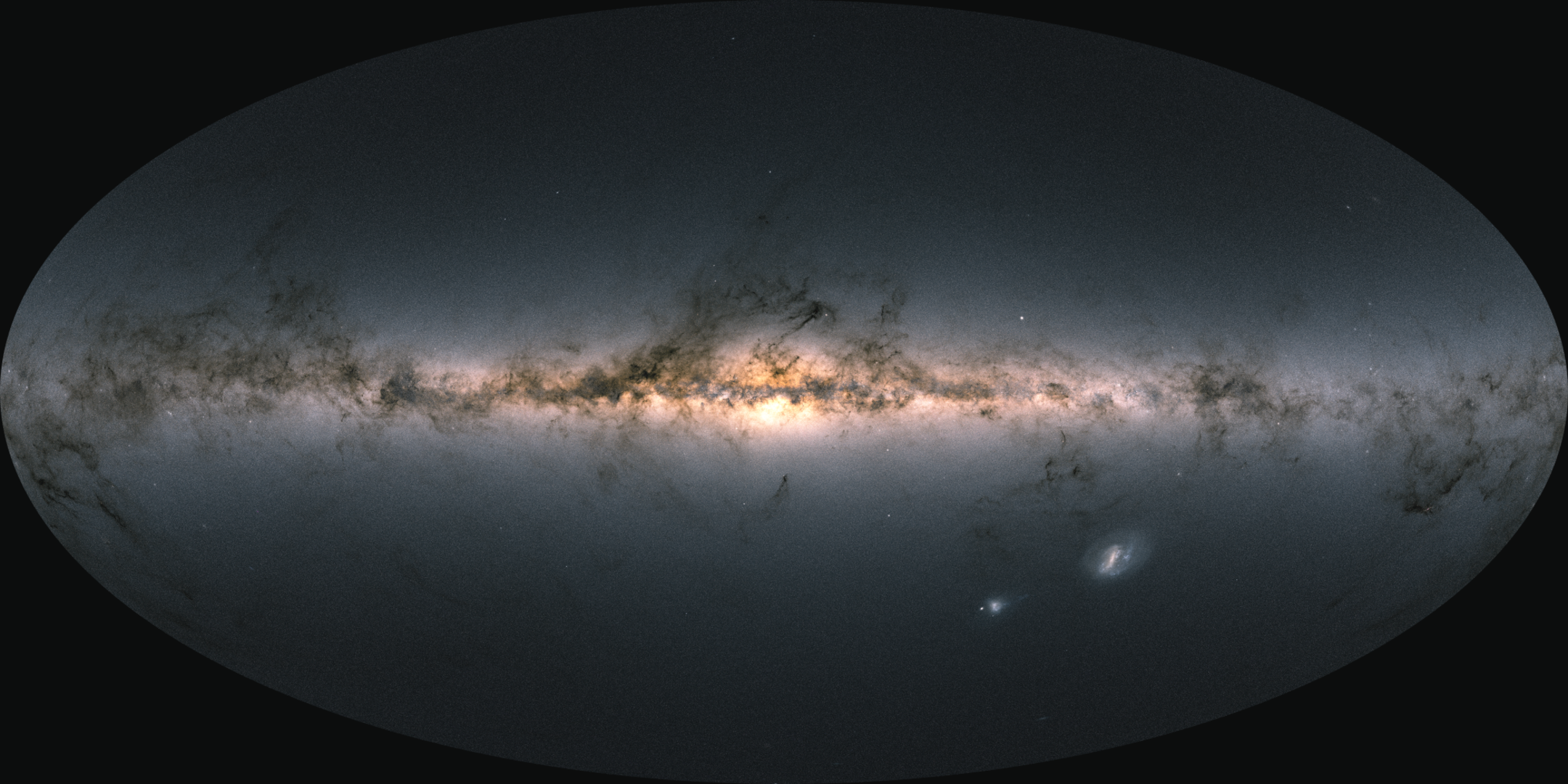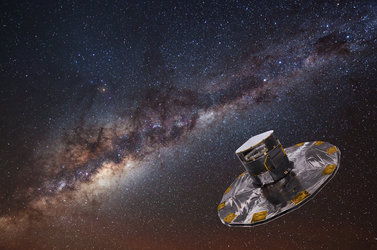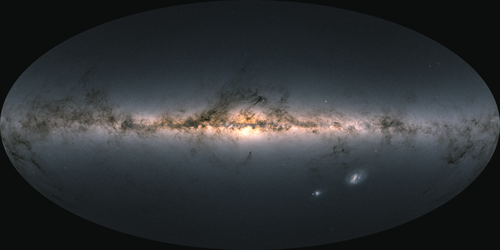Science objectives
Overview
The Gaia mission’s primary objective is to survey one thousand million (one billion) stars in our galaxy and local galactic neighbourhood in order to build the most precise 3D map of the Milky Way and answer questions about its origin and evolution. The mission’s secondary objectives reveal Gaia as the ultimate discovery machine. It is expected to find up to ten thousand planets beyond our Solar System and observe hundreds of thousands of asteroids and comets within it. The mission also reveals tens of thousands of failed stars and supernovae, and even tests Einstein’s famous theory of General Relativity.
Charting the history of the Milky Way
Our galaxy is a disc of some one hundred billion stars in a spiral structure surrounding a central bulge. While many stars were born and grew up here, many others originated in small external galaxies that have subsequently merged with ours.
Since each celestial object preserves something of the era during which it was born, Gaia’s detailed census of every star’s position, motion, brightness and colour allows astronomers to painstakingly piece together the history of our galaxy.
Thanks to Gaia we can discriminate between generations of star – essentially plotting a ‘family tree’ of the Milky Way’s history. As stars condense out of celestial clouds of gas, they naturally incorporate the chemicals found in space. The stars then process this material in their hearts and expel it at the end of their lives, enriching the galaxy with new, heavier chemical elements that are incorporated into the next generation of stars.
Gaia was also able to detect the motions of the stars as they move through space. Taken with the compositions, Gaia allows astronomers to identify families of stars that may have once belonged to different galaxies outside of the Milky Way, but which were since consumed by our galaxy. Thus Gaia essentially put the motions of the Milky Way’s stars into ‘rewind’ to learn more about where they came from.
Alien worlds
Gaia looked at hundreds of thousands of stars beyond our own Solar System to about 500 light years from Earth. It watched for tiny wobbles as they are tugged by the gravitational pull of orbiting planets. Estimates suggest that in Gaia data, scientists will detect thousands – if not tens of thousands – of Jupiter-sized planets beyond our Solar System throughout the course of its mission.
Rogue asteroids
Detecting asteroids and assessing their threat to Earth commands a great public and scientific interest. Gaia contributed to this search through its unprecedented sensitivity to faint, moving objects. Astronomers expect to discover tens of thousands of asteroids with Gaia, some of which will be near-Earth objects, while others will live in the 'main-belt' of asteroids between Mars and Jupiter, or in the icy realms of the outer Solar System known as the Kuiper Belt.
Gaia was also ideally suited to search for asteroids close to the Sun – a blind spot where ground-based telescopes cannot see because they would have to look into the daytime sky. It was able to study their surface properties and rotation rates by measuring how much light is reflected in a particular colour.
Gaia also studied the asteroids we already know to exist, accurately determining the positions and velocities of more than 200,000 asteroids in order to refine their orbits with unprecedented precision.
Comet showers
A large cloud of icy bodies – comets – envelops the Solar System. Occasionally comets are dislodged by a passing star, sending a shower of icy debris into the inner reaches of the Solar System, peppering the Earth and other planets. As Gaia surveyed the stars, it was able to rewind their motions to reveal those stars that may be the perpetrators of such comet showers. Equally, Gaia’s census will help predict future encounters.
Failed stars
Gaia hunted for brown dwarfs – ‘failed stars’ that fell short of the mass needed to spark nuclear fusion in their hearts to achieve star-status. Vast numbers are predicted to be drifting through space, but observations appear to be falling short. Dubbed ‘the brown dwarf desert’, Gaia tracked down these ‘missing’ objects – if they are there.
Exploding stars
One possible end point for a star’s life is to burn out in a dramatic supernova explosion, briefly lighting the sky with a flood of radiation. Over the course of its mission, it is expected that Gaia detected tens of thousands of supernova in distant galaxies, before they reach their maximum brightness. Often these events are not noticed until during or even after their maximum brightness, but it is essential to observe such supernovae as they are still climbing in brightness because the peak brightness is the essential measurement for calculating their distance. Gaia was able to provide an early warning system for astronomers on Earth who wish to study supernovae as they reach their maximum brightness.
Space warps
Space isn’t flat; it contains numerous warps and dips caused by the gravity of massive objects like the Sun and planets. These ‘dips in the road’ can deflect light from a straight line of travel. Gaia’s sensitivity allowed astronomers to see this deflection with the highest precision ever. Albert Einstein’s General Theory of Relativity describes these warps and how they must be taken into account when interpreting data such as from Gaia. In turn, Gaia’s measurements offer scientists the chance to test key parts of Einstein’s equations to unprecedented levels. It will provide an upper limit on the strength of gravitational waves – ripples in the fabric of space-time, and confirm the strength of gravity.







